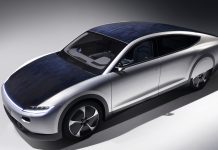
Moss is regarded as a menace by gardeners who seek to eradicate it from their lawns. Now researchers all over the world are exploring how moss, algae and plants could be used as a source of renewable energy in the future.
A team of designers and scientists at Cambridge University will be exhibiting a novel moss table at the London Design Festival later this week. The prototype table will showcase an emerging technology called biophotovoltaics (BPV) which uses the natural process of photosynthesis to generate electrical energy.
Featuring biological fuel cells made from moss, the table has been created as a vision of the future by Alex Driver and Carlos Peralta from Cambridge’s Institute for Manufacturing and Paolo Bombelli from the University’s Chemical Engineering and Biotechnology Department.
Still at early stages, biophotovoltaics has the potential to power small devices such as digital clocks. Low cost biophotovoltaics devices may become competitive alternatives to conventional renewable technologies such as bio-fuels in the next ten years.
The appeal of biophotovoltaics lies in its ability to harness a natural process that takes place all around us. Photosynthesis occurs when plants convert carbon dioxide from the atmosphere into organic compounds using energy from sunlight. Plants use these organic compounds – carbohydrates, proteins and lipids – to grow.
When the moss photosynthesises it releases some of these organic compounds into the soil which contains symbiotic bacteria. The bacteria break down the compounds, which they need to survive, liberating by-products that include electrons. The table designed by the Cambridge University team captures these electrons to produce an electrical current.
Carlos Peralta said: “The moss table provides us with a vision of the future. It suggests a world in which self-sustaining organic-synthetic hybrid objects surround us, and supply us with our daily needs in a clean and environmentally friendly manner.”
Looking into the future, possible applications for biophotovoltaics include solar panels, power stations and generators. Currently at concept stage, these are envisaged as sustainable solutions to pressing problems across the world – including the growing need for energy and fresh water from vulnerable communities.
“A modular system of biological solar panels would be mounted on to the roof of a building to supply it with a portion of its energy requirements,” explained Alex Driver “A biophotovoltaic power station would comprise giant algae-coated lily-pads floating on the surface of the ocean near the coastline, generating energy for local communities.
A biophotovoltaic generator would feature algae solar collectors mounted on floating buoys and anchored just offshore to generate energy and harvest desalinated water, which is a waste product of one of the chemical reactions occurring in the device.”



